
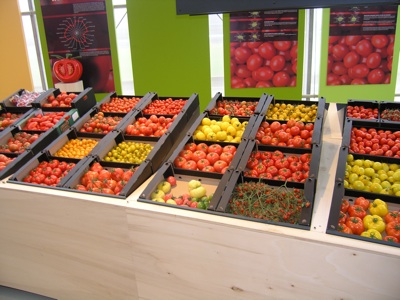 WEB EXCLUSIVE
WEB EXCLUSIVE
‘Small country, great partner’
The Dutch have long been regarded as master marketers and production pioneers in the greenhouse sector, and world leaders in sales and technology.
"Look out the left" the captain said, “the lights down there, that’s where we’ll land …"
Those are the opening lyrics to the Joni Mitchell classic, “This Flight Tonight,” and while the Martinair flight crew didn’t offer such advice on our approach to Schiphol Airport, I did indeed “look out the left” as we made our descent. We had been flying through thick fog for much of the previous 10 or 15 minutes of our overnight flight from Toronto to Amsterdam, and you couldn’t see a thing. That was until I indeed saw “the lights down there” cutting through the fog. My first view of the Netherlands on this trip would be, ironically, of a large greenhouse operation.
| NAKTUINBOUW |
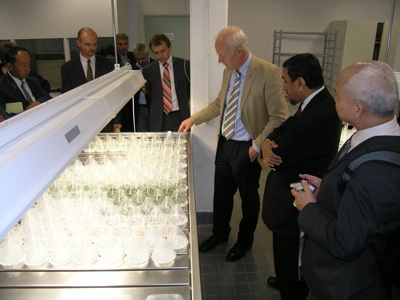
|
| Above: N.C. A. (Nico) Koomen, director of the Netherlands Inspection Service for Horticulture in Roelofarendsveen, describes germination testing procedures. Below: There are 100 seeds per container. |
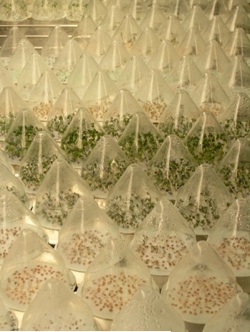 |
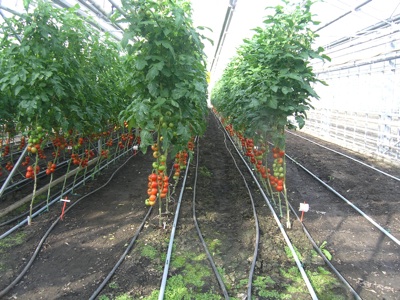 |
| Tomato trials in one of the older greenhouses at the Netherlands Inspection Service for Horticulture. |
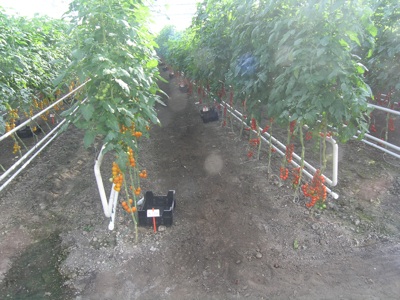 |
| New variety trials being conducted at the Netherlands Inspection Service for Horticulture facilities in Roelofarendsveen. The crops were grown in the soil for consistency. |
This was the start of a week long study tour of horticulture in the Netherlands last fall, hosted by the Netherlands Ministry of Agriculture, Nature and Food Quality. The focus was the Horti Fair trade show, held in Amsterdam in mid-October each year. Other countries represented on the tour included India, Malaysia, Bulgaria, Thailand, Vietnam, Saudi Arabia, Mexico, the Ukraine, Romania, Hungary and South Africa.
The Dutch have long been regarded as master marketers and production pioneers in the greenhouse sector, and world leaders in sales and technology. Canadian growers are keen customers and students of that expertise and experience, incorporating the latest advances from the Netherlands.
Dutch officials are now stepping up efforts to showcase their industry, and develop closer working relationships with growers throughout the world. This was the focus of the study tour, highlights of which included:
- A visit to the Netherlands Ministry of Agriculture, Nature and Food Quality offices in The Hague for an industry briefing by senior officials.
- A tour of Tomato World, a high-tech greenhouse facility that operates as an information and education centre. It features more than 50 different types of tomatoes.
- A visit to the head offices of De Ruiter Seeds, for an overview of some of its vegetable breeding work.
- A morning at the Aalsmeer Flower Auction, the largest facility of its kind in the world.
- A visit to the Naktuinbouw, the Netherlands Inspection Service for Horticulture. It promotes and monitors the quality of products, processes and chains in horticulture, focusing particularly on propagation material, both national and international.
- A tour of Florist de Kwakel, a leading breeder and grower of cut flower and potted gerbera, and anthurium.
- A vist to the new research greenhouses of Wageningen University in Bleiswijk.
- And, of course, two days browsing the many aisles and displays of Horti Fair. (That tour will be published next issue.)
TOUR INTRODUCTION
Roel Bol is director of Trade and Industry with the Netherlands Ministry of Agriculture, Nature and Food Quality. He emphasized the trading history of the Netherlands, a country of 16.5 million people with a gross national product of some 525 billion euros ($815 billion Cdn).
The domestic agricultural technology industry is fully developed, and is stepping up efforts to develop partnerships with other countries. “Except for glasshouses, our growing season is limited. We want to invest with our partners.”
Such partnerships, he emphasized, must be
“win-win” situations and would include the transfer of Dutch technology and innovation. This would help growers throughout the world add value to their products. A “Triple-P” decision-making model would focus on people, the planet, and on profits. “There should be only winners with our partnerships.”
| HALUCO |
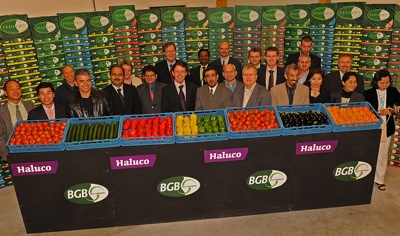
|
| Delegates from Asia, Europe, Africa, Central America and Canada (me, front row) were part of the study tour hosted by the Ministry of Agriculture, Nature and Food Quality of the Netherlands. Haluco BV commercial director Johan Hensen is front row, 7th from right. |
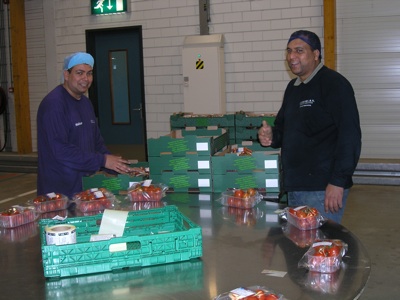
|
| Tour delegates view part of the pepper packing. |
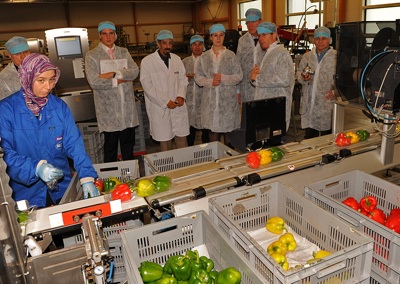
|
| Haluco employees on the packing line. |
New technologies are being developed at a rapid pace, and the Netherlands is eager to invest that technology in other regions.
Agriculture accounts for 10 per cent of the country’s GNP and one in 10 jobs. It has a strong international focus, especially within the European Union. The Netherlands is second only to the United States ($104 billion) in agricultural product exports, shipping some $73 billion. Canada is tied for sixth with Brazil ($42 billion).
Horticulture is a major industry in the Netherlands. One out of every three trucks on the country’s roads are carrying flower and food products; one in 10 is transporting ornamentals. Agricultural exports represent 20 per cent of total exports. Its leading export is cut flowers ($3.1 billion, representing 84 per cent of the world market). Flower bulbs are number two ($892 million, and 83 per cent of the world market).
“Knowledge and innovation are very important” in trading partnerships, said Bol, and the Netherlands has specialized in a couple of agricultural sectors, such as dairy and horticulture. Some 52 per cent of the country is farmland, and the majority of those are still family operations.
Among technologies being advanced is a greenhouse that would also be a net power producer, he added.
The Netherlands has always been a major international trading nation, and that tradition is being advanced through its “Small Country, Great Partner” marketing initiative.
NAKTUINBOUW
The Netherlands Inspection Service for Horticulture, known as Naktuinbouw, promotes and monitors the quality of products, processes and chains in horticulture, focusing particularly on propagation material, both domestic and international. It is located in Roelofarendsveen, and covers the complete spectrum of Dutch horticulture, with the exception of flowering bulbs.
Director Nico Koomen was our tour host. He noted the program was initiated in 1941, not by government, but by growers who saw the importance of quality control standards. “This quality assurance focus is one of the reasons for the strength of the Dutch agriculture industry,” said Koomen.
| TOMATO WORLD |

|
| Some of the 60 tomato varieties being grown at Tomato World, prominently displayed in the education centre. |
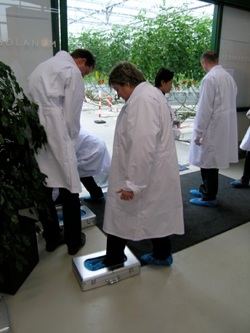 |
| Above and Below: Step right up. High-tech even applies to how shoe “booties” are automatically applied. |
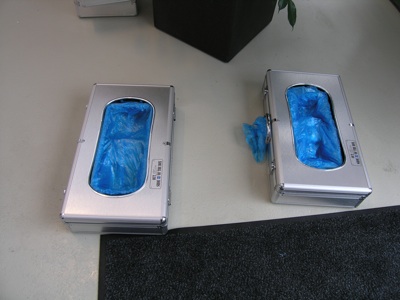 |
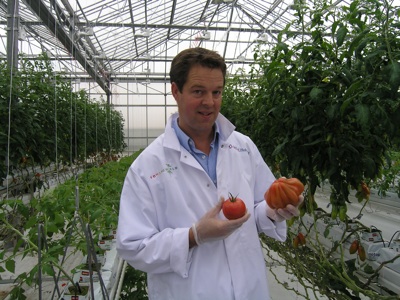 |
| A traditional, and a not-so-traditional tomato. |
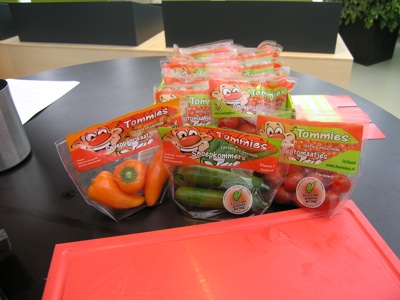 |
| The Tommies product line of greenhouse peppers, cucumbers and grape tomatoes are great examples of branding snack foods. |
Quality assurance means trucks can travel freely throughout the European Union.
Naktuinbouw also provides crop diagnostic services. “Growers can send in samples of diseased plants,” said Koomen. “It’s so important to get a quick diagnosis.”
Additional greenhouses were constructed in 2007. Divided into 18 trials section, the new complex covers 1,800 square metres.
HALUCO
Haluco BV has one of the country’s most automated packing facilities. The company was launched in 1972 following the merger of two family-owned companies – Havenaar and Van der Lugt. It is a marketing organization for affiliated growers at home and abroad, noted commercial director Johan Hensen.
He explained that 75 per cent of greenhouse vegetables grown in the Netherlands are exported, primarily throughout Western Europe, with some sales into the U.S. New markets are being developed in Armenia, Bosnia and the Ukraine, among other countries.
Orders received by 8 a.m. are shipped by 8 p.m. that same day. Supermarkets expect same-day service, Hensen explained.
One of their major sources of greenhouse produce is the Best Growers Benelux (BGB), a co-operative of 70 growers with 300 hectares. Other supplies come from Spain, the Canary Islands (220 hectares under glass), and Israel.
Energy is the key challenge. Increasingly, growers are tapping alternative energy sources or technologies, Hensen explained.
- Geothermal systems are being drilled up to 200 metres deep.
- Cogen units allow growers to generate electricity and at the same time utilize the heat.
- The so-called “closed greenhouse” technology is also increasingly popular.
“The question is, how can we bring our energy expenses down?"
Food miles will become an issue with consumers over the next five to 10 years, said Hensen. As another trend, he said that organic produce often receives double the price of regular fruits and vegetables.
The Haluco warehouse is two years old. Its unique heating system includes an aquifer from which warm water is drawn in the winter, and cool water in the summer. Solar collectors on the roof are used to heat water, resulting in significant energy savings.
The building is 11,700 square metres. However, Hensen notes that without the many automated system, the company would have had to build a facility about twice that size to handle its volumes.
It has storage capacity of 1,800 pallets linked to a high-tech internal transport system that includes five cranes, one for each compartment, and automated chain conveyor lines. Pallet bar codes that store product and client specifications. The system is among the first of its kind in Europe.
TOMATO WORLD
The name says it all. Everything you ever wanted to know about greenhouse tomatoes – and more – is displayed within this innovative 1,500-square-metre facility in Honselerdijk. It’s a fully functioning, production-style greenhouse featuring some 50 varieties and a number of different growing techniques, but it’s primarily an industry showcase of marketing ideas and trends.
Tomato World is the brainchild of longtime grower Jos van Mil. He initially developed plans for the project with his four colleagues from the grower group, Greenco. It has grown to include 40 leading companies in the sector, all displaying their latest varieties and technologies. Eight seed companies are involved.
A major focus is industry education. Tomato World hosts visits by growers and their customers, retail employees working in produce departments, and consumers. Among recent visitors was a delegation from the Chinese Ministry of Agriculture.
“We cover the entire chain,” said van Mil, “to show how we produce a very pure product, from propagation to retail.”
It’s also hoped Tomato World will inspire more young people to consider careers in horticulture.
| AALSMEER AUCTION |
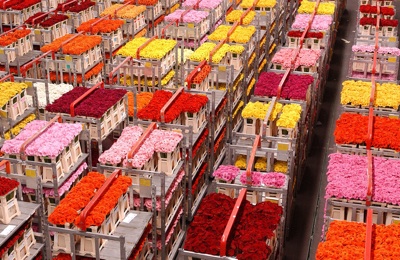
|
| A sampling of some of the product carts. |
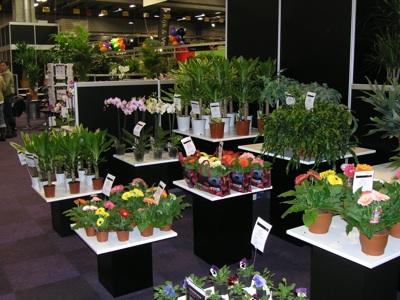 |
| Aalsmeer Flower Auction hosts a Market Expo during Horti Fair. Some 500 booths displayed a variety of new products and retail concepts. |
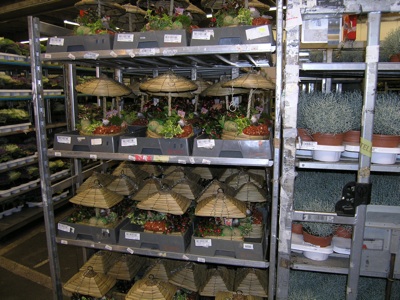 |
| The Aalsmeer auction also includes a wholesale market, a cash-and-carry service for members. |
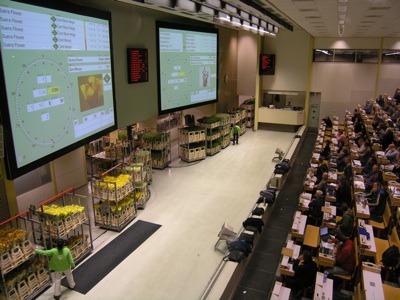 |
| The flower auction features five auction halls and 14 clocks. |
DE RUITER SEEDS
De Ruiter Seeds is a leading breeder of hybrid vegetable seeds for the tomato, cucumber, eggplant, sweet pepper, melon and rootstock sectors.
Hosting the visit – due to product purity protocols, no tour of the actual breeding facilities was possible – were corporate sales director Martin van der Voort and communications manager Marleen van Balkom.
De Ruiter Seeds was founded in Bleiswijk in July of 1945 by Wouter De Ruiter. He began with seed potatoes, among other crops, before expanding to breed and produce seeds himself.
Among early breeding milestones for the company was the cucumber variety ‘Sporu,’ which was immune to spot virus. Soon after, it developed the ‘Sonato’ tomato variety that was resistant to the tobacco mosaic virus. The company expanded into peppers and eggplants in the 1980s, and into rootstock in the 1990s. Numerous other innovations have followed over the years.
The company’s head offices in Bergschenhoek include seven hectares of greenhouse space available for breeding.
De Ruiter Seeds was acquired by Monsanto in 2008, and became Monsanto’s “centre of excellence” for vegetable seeds in protected cultures.
De Ruiter has some 1,000 employees in 14 countries, with research and development carried out in four countries. It has production facilities in five countries.
“We have to respond quickly to market conditions,” said van der Voort. “Any new development takes four to five years before it’s ready to be introduced as a new commercial variety.”
The company has an extensive seed quality testing system. A healthy crop begins with top-quality seeds, said van der Voort.” Each bag of seeds is barcoded, “so it can be easily traced.”
AALSMEER AUCTION
Bloemenveiling Aalsmeer is the world’s largest flower auction, as confirmed by the Guiness World Records people. The aution building component
is the largest single trading facility in the world in terms of floorspace, covering 1.25 million square metres (about 309 acres). It has 523 loading docks for trucks.
| FLORIST DE KWAKEL |
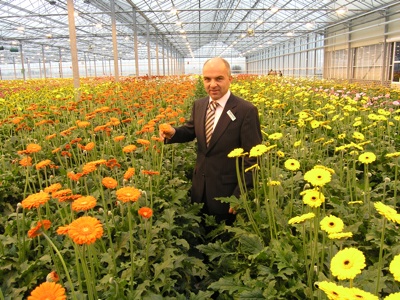 |
| Rene van Berlo is manager of R&D with the company, a leading gerbera and anthurium breeder in the Netherlands. |
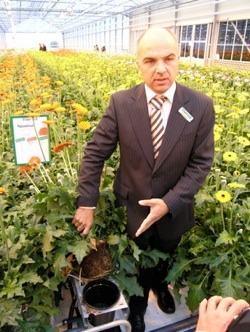 |
| Some 70 per cent of gerbera growers use cocopeat. |
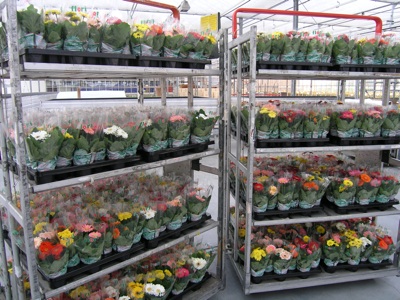 |
| About 30 per cent of gerbera production are potted varieties. |
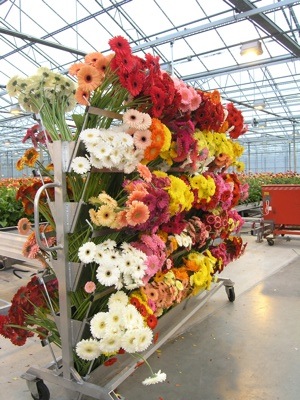 |
| Freshly harvested gerbera stems, ready for market. |
Featuring five auction rooms and 14 clocks, it handles an average of 39,995 clock transactions each day. It has over four million stacking carts and Danish containers in circulation.
The top 10 cut flowers sold by FloraHolland – Aalsmeer is one of six FloraHolland auctions – in 2008 included (in order), roses, spray mums, tulips, lilies, gerbera, cymbidium, disbudded mums, freesia, anthurium and amaryllis. The top 10 potted plants included phalaenopsis, anthurium, kalanchoe, dracaena, ficus, roses, mums, hydrangea, Peace Lily and hyacinth. The top 10 outdoor plants were geranium, boxwood, violet, Cape Daisy, petunia, lavender, hydrangea, fuchsia, heather and skimmia.
The top 10 importing countries are Kenya, Israel, Ethiopia, Ecuador, Germany, Belgium, Zimbabwe, Denmark, Spain and Tanzania. The top 10 imported products are roses, baby’s breath, St. John’s wort, carnations, calla lilies, ornithogalum, ranunculus, rhododendron, goldenrod and speedwell.
The most important FloraHolland markets include Germany, United Kingdom, France, Italy, Belgium, Russia, Poland, Denmark, Switzerland and Austria. The U.S. was 14th, while Canada did not make the top 25.
The auction is a co-operative, owned by 5,000 growers. FloraHolland employs 4,000 people, and has total sales of more than $6.3 billion.
FLORIST DE KWAKEL
Florist de Kwakel is one of the world’s largest gerbera and anthurium breeders. The five-hectare greenhouse includes young plant material, seed and seedling production, along with research and development. It has customers in more than 75 countries.
Florist de Kwakel was formed in 1975. All the breeding and hardening off of the plants is done in the Netherlands, while tissue culture work is done in India.
“We have extensive testing before varieties are introduced,” explained R&D manager Rene van Berlo. About 25 to 30 new varieties debut each year. “There are so many markets we serve, and each has different needs.”
Exceptional varieties remain in the market for about 15 years or so, with the average being four to five years.
Gerbera are difficult to transport and must be packaged carefully. “They’re best suited for local markets,” said van Berlo. This offers gerbera growers protection from imports.
Over the past 20 years, the shelf life of cut flowers has greatly increased through breeding. Cut flowers should last about 14 days at the consumer level, said van Berlo.
He said while the floriculture industry has done a great job promoting its products, it’s been shy about tooting its own horn. “We’re not getting enough students studying horticulture,” he said. “This is an interesting and innovative economic sector. We need the mass media to reach young people. It’s hard to find good, young breeders coming out of the universities.”
Government has a role to play in fostering greater innovation, “but industry has the greater responsibility.”
About 70 per cent of gerbera production at Florist De Kwakel B.V. is cuts.
| WAGENINGEN UR |
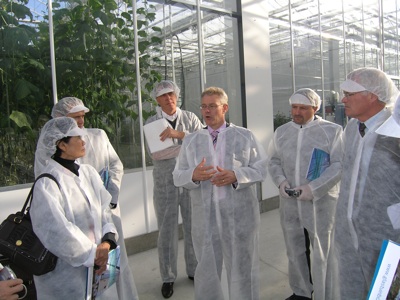
|
| Dr. Sjaak Bakker, business unit manager of greenhouse horticulture, hosted the tour of the Wageningen UR greenhouses. |
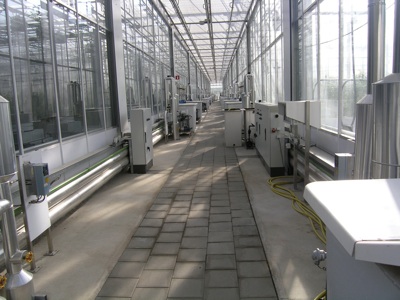 |
| Equipment corridors allow all work to be done on equipment without disturbing an experiment. |
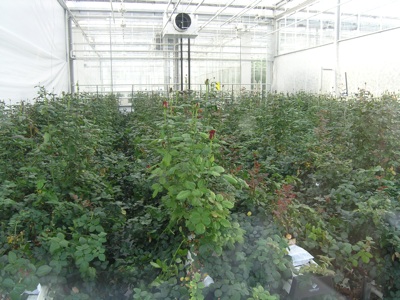 |
| This rose trial was looking at the effect of blocking near-infrared light from a rose crop. |
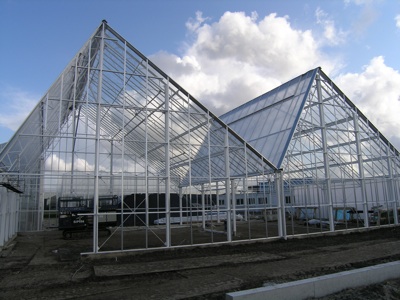 |
| A new greenhouse design that will heat water for storage. |
WAGENINGEN UR
Wageningen UR is a collaboration between Wageningen University, Van Hall Larenstein School of Higher Professional Education, and the specialized former research institutes (DLO) of the Dutch Ministry of Agriculture. It has 5,600 staff and more than 8,500 students working to solve scientific, social and commercial problems in the field of life sciences and natural resources.
“Wageningen UR aims to make a real contribution to our quality of life,” notes its website. “To us, quality of life means both an adequate supply of safe and healthy food and beverages, on the one hand, and the chance to live, work and play in a balanced ecosystem with a large variety of plants and animals.”
Dr. Sjaak Bakker is business unit manager of greenhouse horticulture, one of 15 programs operated by Wageningen UR.
The majority of problems they tackle are current production challenges, he explained. By 2020, for example, they hope greenhouses will be energy sustainable without the need for fossil fuels.
Nutrient recycling is a major thrust, as the industry is working towards completely closed systems with no leaching.
Labour-saving technology is another key initiative. “Over the past 20 years, labour costs have doubled,” said Dr. Bakker. “A lot of our efforts are going into automation and robotics.”
Lighting is also important. But while it is important for crop production, there are growing concerns with light pollution from greenhouses. LEDs may be part of the solution, and extensive research is being carried out with them.
Researchers are also looking at how excess heat from greenhouses can be directed to nearby residential communities. “Most greenhouses (in the Netherlands) are close to urban areas,” said Dr. Bakker.
All of their research is decided by a grower advisory board, he said. “It’s the board that sets the priorities.”
Visit our photo gallery for more photos!
Print this page